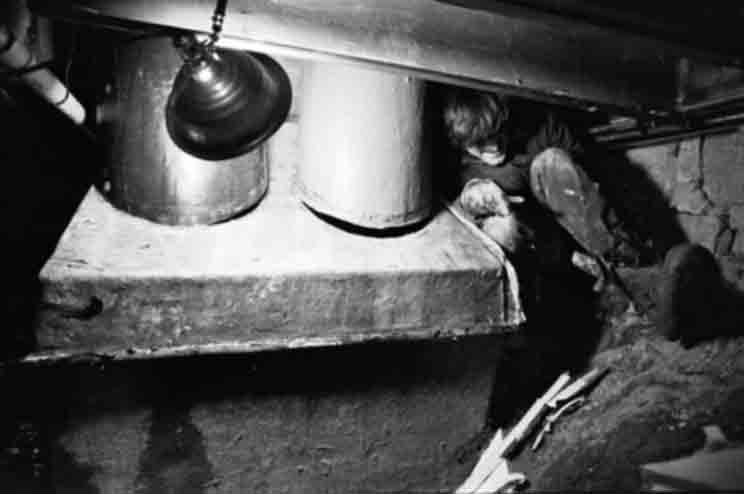
Concrete Compost Toilet Containers
First, a fiberglass, Clivus Multrum compost toilet is shown, (a 1978 installation).

How I learned about compost toilets.... In the 1970's I worked part time for the leading compost toilet company of the time, by the name of Clivus Multrum. A stock yard was located in Surry, Maine, which was a 100 minute drive from me. I became the primary field guy who went around fixing poor installations and also fully replaced some leaky units. Above, is my good old friend who help me with a few jobs and here he demonstrates the challenge of working in a typical Maine crawl space. They paid very well;)
2012: My work with a bio digester composter is here.
Next a unit built in 2002
Pictures below are of toilet built in the tropics. Warm conditions observably composts waste sooner. In cooler climates, indoor temperatures can keep the compost action "moderately warm". A steady state of healthy, aerobic composting benefits from moderate temperature. Warmth and ventilation can prevent excess liquid buildup, (important in a cold or in high humidity climate, with a sealed toilet system). An unheated, cold climate outhouse generally builds up waste material without composting and liquid filters away through soil.
This report is based only on building methods and aerobic garden composting experiences of Bo Atkinson. My compost design below is based on several years of experience working for the original Clivus Multrum USA company, (Cambridge Massachusetts), during the mid 1970's. Bo's job back then was to fix problems in the field due to manufacturing defects in fiberglass toilet construction and to implement design experiments directed by the son of the inventor of this Swedish toilet. While the following design does not copy features exclusively of the Clivus Multrum, it does incorporate the field experience learned the hard way. I have perhaps 40 years experience in aerobic composting work and observations of long term garden composting. Nothing more than personal observation and opinion is offered here.
Bo's essential concept is to aerate the fecal compost by using just enough
decomposing twig or garden material. However, tissue should
not be overly
deposited as to rapidly over-fill
the container. A high-quality, non-sterile condition is
the objective. Partially
decomposed additions to the container over time help ensure maintenance
of a viably
aerobic, composting
mass. Aerobic compost is preferred for compost toilets because of
proven pathogens destruction. The toilet
container
is initiated with a small brush pile. Next--
select
leaf
molds
and choice
top soil humus
is lightly
sprinkled over the top of initial brush pile. (Neutral pH is desirable).
A chimney
style vent is fitted near top of bench. Bench also has tight closing seat
for users, to reduce chances of odors pervading the seat area, (or room
enclosure). Inlet ventilation should be provided through one or more
small holes in concrete.
Air inlet holes are screened to reduce bug access and these holes should
not
allow rain or light to enter. The light might attract insects which could
eventually block the air inlets. Flying insects have been tolerated in
compost toilet ecosystems. Absolutely selective toilet ecosystems which
exclude all undesirable life forms might become available, (if the compost
toilet networks develop favorably).
In the mean time a person may select organic remediation remedies in case
of insect outbreaks. Organic methods are preferred in order not to interfere
with aerobic composting. .The best remedy
for
flying insects might be to attract them to light from
the
outlet vent since flying insects tend to fly upwards and towards light.
A screen
trap
can be made in the outlet (roof) vent and unwanted insects can be trapped
there. The screen prevents new insects from entering. Equally important,
the Provision should be made to easily keep this vent
clean.and
clear of dead insects.
The pile of sticks inside ventilate the bottom of container where urine
tends
to
collect. The large flat bottom provides ample evaporation needed within
compost toilets. As fecal matter accumulates on top of pile, more leaf mold
and twigs
are recommended to provide for 3 needs:
1] internal ventilation within the fecal mass
2] ample carbon balance
3] choice micro eco-systems to improve compost
Twigs will incorporate more ventilation than would saw dust or peat moss which tend towards undesirable acidity. Twigs and choice humus provide better pH control for improved aerobic compost action.
Fire safe construction is desirable in the rare and unforeseen case of misuse such as a guest who stupidly throws a lit cigarette into compost toilet, which is very dry and overfilled with combustibles. I knew of a house fire started by hot stove ashes placed into a fiberglass composting toilet. So beware.
CAD visualization, however the pictured unit was finished differently. More building details will eventually be added here.
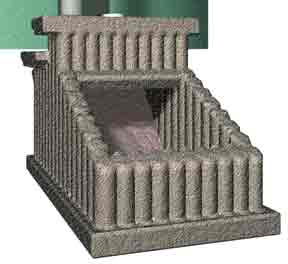
Pictures Below--Construction using cage mesh. First, tubes of mesh are made and a slab form is also made of boards. Then mesh tubes are arranged inside form for slab where they are linked together with horizontal rod. (Horizontal rod bulges the cement in the third picture below). The assembled mesh forms are put aside to pour slab concrete. After pouring slab, the mesh assembly is immediately placed on top of wet slab. Tubes are immediately filled with concrete to better seal wall and slab, ( to prevent leakage). Picture shows first stage which was poured along with other concrete work that day. Weeks later the bench, lid, etc., were added. (The deadline was too close to stop for pictures, besides interruptions of rain and flash floods and other projects). More pictures and notes on the general "corduroy" tube method for forming concrete walls is linked below.
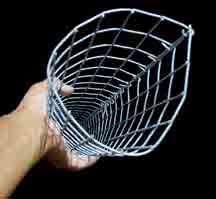
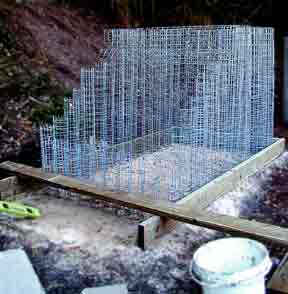
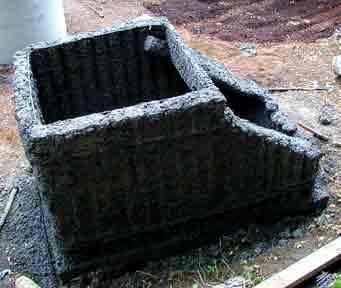
2012: Composting Bio Digester project, with more diagrams and concepts.
0ddress.gif
Comments are invited and consultancy is offered. These research reports are in the The content on this website, http://harmoniouspalette.com, is placed in the public domain only as a free exchange of ideas and as a "hard studied wish to serve life". The author assumes no responsibility for the improper use of the concepts in these web pages. All relevant laws of life and local codes should be verified and observed before any building or experimentation proceeds. discussion is welcome, please write. Bo Atkinson and are furnished "as is". The author makes no warranty, express or implied, for any purpose. The author assumes no responsibility for the use or misuse of this research. Bo Atkinson, enersearch Tel : 207 342 5796 . . . (Maine USA)